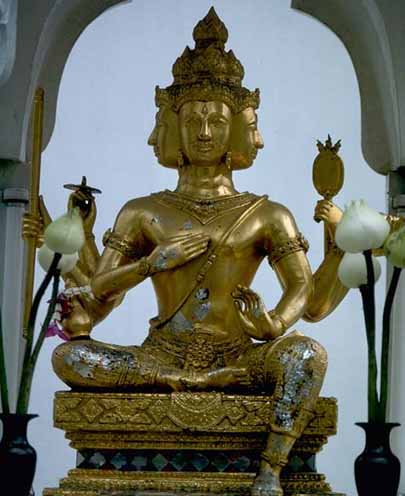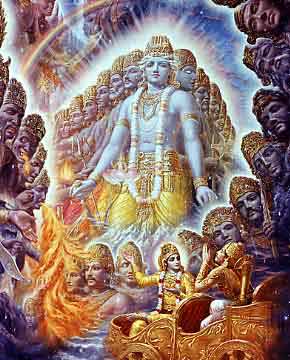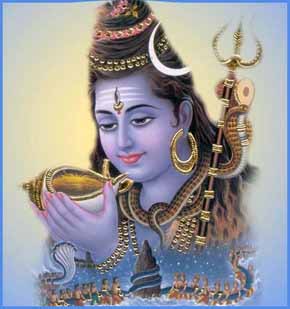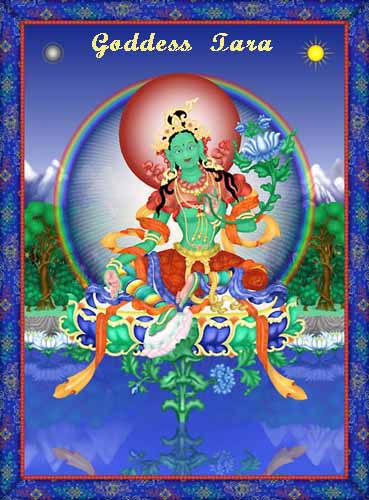Within Smarta Hinduism, a variety of forms of God are seen as aspects of the one impersonal divine ground, Brahman (not Brahma). Brahman is seen as the universal spirit. Brahman is the ultimate, both transcendent and immanent the absolute infinite existence, the sum total of all that ever is, was, or ever shall be.Brahman is not a God in the monotheistic sense, as it is not imbued with any limiting characteristics, not even those of being and non-being, and this is reflected in the fact that in Sanskrit, the word Brahman is of neuter (as opposed to masculine or feminine) gender.
Vedanta is a branch of Hindu philosophy which gives this matter a greater focus. Yoga is the primary focus in many ways of a Hindu's religious activities, being somewhere between meditation, prayer and healthful exercise.
Some of Hinduism's adherents are Smarta monists, seeing multiple manifestations of the one God or source of being, which is often confused by non-Hindus as being polytheist. It is however properly seen as one unity, with the personal gods being different aspects of one Supreme Being, like a single beam of light separated into colors by a prism, and are valid to worship.
Swami Vivekananda, a follower of Ramakrishna, along with many others, who brought Hindu beliefs to the West, were all Smarta in belief. Other denominations of Hinduism, as described later, don't hold this belief strictly and more closely adhere to a Western perception of what a monotheistic faith is. Additionally, like Judaeo-Christian-Islamic religions which believe in angels, Hindus also believe in less powerful entities, such as devas.
In Hinduism, the Trimurti (also called the Hindu trinity) are three aspects of God in His forms as Brahma, Vishnu and Shiva.

�Brahma is the Hindu god (deva) of creation and one of the Trimurti, the others being Vishnu and Shiva. He is not to be confused with the Supreme Cosmic Spirit in Hindu Vedanta philosophy known as Brahman. Also, in Sanskrit Grammer, Brahman is Nominative Singular of generic word Brahman, as Aatma is Nominative Singular for Aatman. Brahaman and Aatman are same in Vedanta Philosphy, the Para-Aatma (Supersoul) and Jeeva Aatma (Individual Soul) are Brahman. His consort is Saraswati, the goddess of learning. Brahma is often identified with Prajapati, a Vedic deity.
According to the Puranas, Brahma is self-born (without mother) in the lotus flower which grew from the navel of Vishnu at the beginning of the universe. This explains his name Nabhija (born from the navel). Another legend says that Brahma was born in water. In this he deposited a seed that later became the golden egg. From this golden egg, Brahma the creator was born, as Hiranyagarbha. The remaining materials of this golden egg expanded into the Brahmanda or Universe. Being born in water, Brahma is also called Kanja (born in water). Brahma is said also to be the son of the Supreme Being, Brahman and the female energy known as Prakrti or Maya.
At the beginning of the process of creation, Brahma created eleven Prajapatis (used in another sense), who are believed to be the fathers of the human race. The Manusmriti enumerates them as Marichi, Atri, Angirasa, Pulastya, Pulaha, Kratu, Vasishtha, Prachetas or Daksha, Bhrigu, and Narada. He is also said to have created the seven great sages or the Saptarishi to help him create the universe. However since all these sons of his were born out of his mind rather than body, they are called Manas Putras or mind-sons.
Within Vedic and Puranic scripture Brahma is described as only occasionally interfering in the affairs of the other devas (gods), and even more rarely in mortal affairs. He did force Soma to give Tara back to her husband, Brihaspati. He is considered the father of Dharma and Atri.

He is most famously identified with His avatars, or incarnations of God, most especially Krishna and Rama. Additionally, another important name for Vishnu is Narayana.

�Shiva is considered to be the supreme deity in Shaivism, a denomination of Hinduism. Many Hindus such as those of Smarta tradition are free to accept various manifestations of the divine as their chosen deity for worship, and those who prefer Shiva are called Shaivas. Shaivism, along with Vaisnava traditions that focus on Vishnu, and Sakta traditions that focus on the Goddess (Devi) are three of the most influential denominations in Hinduism.
The worship of Shiva is a pan-Hindu tradition, practiced widely across all of India. Shiva is one of the five primary forms of the Divine in Smartism, a denomination of Hinduism that puts particular emphasis on five deities, the other four being Vishnu, Devi, Ganesha, and Surya. Another way of thinking about the divinities in Hinduism identifies Brahma, Vishnu, and Shiva as each representing one of the three primary aspects of the Divine in Hinduism, known collectively as the Trimurti. In the Trimurti system, Brahma is the creator, Vishnu is the maintainer or preserver, and Shiva is the destroyer or transformer.
Although the pantheistic system allowed only a subordinate rank to the old polytheistic gods, and the actual religious belief of the people was probably but little affected by their existence, they continued to occupy an important place in the affections of the poet, and were still represented as exercising considerable influence on the destinies of man. The most prominent of them were regarded as the appointed Loka palas, or guardians of the world; and as such they were made to preside over the four cardinal and (according to some authorities) the intermediate points of the compass.
Thus Indra, the chief of the gods, was regarded as the regent of the east; Agni, the fire, was in the same way associated with the southeast; Yama with the south; Surya, the sun, with the southwest; Varuna, originally the representative of the all-embracing heaven (atmosphere), now the god of the ocean, with the west; Vayu (or Pavana), the wind, with the northwest; Kubera, the god of wealth, with the north; and Soma with the northeast. (Note: In some traditions, Eesana, an aspect of Siva is regarded as the regent of the northeast and Nirrti the regent of the southwest.)
In the institutes of Manu the Loka palas are represented as standing in close relation to the ruling king, who is saki to be composed of particles of these his tutelary deities. The retinue of Indra consists chiefly of the Gandharvas, a class of genii, considered in the epics as the celestial musicians; and their wives, the Apsaras, lovely nymphs, who are frequently employed by the gods to make the pious devotee desist from carrying his austere practices to an extent that might render him dangerous to their power. Narada, an ancient sage (probably a personification of the cloud, the water-giver), is considered as the messenger between the gods and men, and as having sprung from the forehead of Brahma.
The interesting office of the god of love is held by Kamadeva, also called Ananga, the bodyless, because, as the myth relates, having once tried by the power of his mischievous arrow to make Siva fall in love with Parvati, whilst he was engaged in devotional practices, the urchin was reduced to ashes by a glance of the angry god. Two other mythological figures of some importance are considered as sons of Siva and Parvati, viz. Karttikeya or Skanda, the leader of the heavenly armies, who was supposed to have been fostered by the six Knittikas or Pleiadesand Ganesha (lord of troops).
Smartism, a denomination of Hinduism is a monist as well as a monotheist religion that understands different deities as representing various aspects and principles of one supreme entity, Brahman or parabrahman. After all, Swami Vivekananda, a follower of Ramakrishna, along with many others, who brought Hindu beliefs to the West, were all Smarta in belief. Other denominations of Hinduism do not strictly hold this belief. Only a Smartist would have no problem worshiping Shiva or Vishnu together as he views the different aspects of God as leading to the same One God. It is the Smarta view that dominates the view of Hinduism in the West. By contrast, a Vaishnavite considers Vishnu as the one true God, worthy of worship and other forms as subordinate.
Vedic Deities - These deities represent forces of nature or devas and are not equivalent to Brahman represented as Vishnu or Shiva. The Devas hold a similar place in relation to God as angels do in Judaeo-Christian traditions.
Aditi - Hindu Great Goddess, as the Woman Clothed with the Sun. Sun Goddess, Mother of all the Lights of Heaven. She gave birth to the twelve zodiacal spirits.
Ananta - Indian Serpent Queen. aka Sarparajni. She enveloped all gods during their death, sleeping between incarnations.
Banka-Mundi - Hunting Goddess of the Khoud. Merely uttering Her name made one fearless against jungle beasts.
Bardaichila - Assamese Storm Goddess.
Bentakumari - Assamese Water Goddess. First fish of the season was given to Her.
Bhasundara - Tibetan Goddess of Prosperity
Bhavani - Common name for Mother Goddess of India. Bestower of Existence. Evoked by women in labor, who burned perfume to honor Her.
Bisal-Mariamna - Shakti of Sunlight in Mysore. Symbolized by a brass pot full of water called the Kunna-Kannadi or 'eye mirror'. Into this pot are put pepper leaves and coconut flowers, a small metal mirror leans against it.
Budhi Pallien - Assamese Forest Goddess, appears as a tiger roving through the Indian jungle.
Chomo-Lung-Ma - Goddess Mother of the Universe, original name of Mt. Everest. One of the oldest Indian deities.
Devi - Dearly Beloved Goddess
Durga - the Queen Mother, Warrior Goddess, rode tigers into battle defending Her children, the gods.
Hudigamma - Hindu Mother Goddess served by eunuch priests dressed in women's clothes.
Indrani - Queen of the gods.
Ista Devata - Tantric Patroness of the Self. Individual Guardian Angel of the Enlightened Sage.
Kadru - Serpent Goddess, Mother of the Nagas, or Cobra people.
Kali - Black Earth Mother, Conqueror of Time, Goddess of fertility, death and regeneration. Dark Mother, Hindu triple Goddess of creation, preservation and destruction. Birth and Death Mother. Treasure house of Compassion, Giver of Life to the World. Her mantras brought into being the very things whose names She spoke for the first time, Originator of the creative word or Logos. A triple Goddess - Maiden, Mother, Crone. Lady of the Dead. The Ocean of Blood at the beginning and end of the world. Also known as Jagadamba.
Kauri - Indo-European Swan Goddess. Cowrie shell was sacred to Her.
Khon-Ma - Mother Earth, Ruler of All Spirits emanating from the Earth element.
Kundalini - Serpent Goddess representing the inner power of the human body
Kurukulla - Dravidian Goddess of Caverns.
Lakshmi - Goddess of fortune,wealth and abundance. Portrayed as a golden skinned woman sitting or standing on a lotus, Her symbol. Hindu Goddess of Sovereignty. Source of the divine drink Soma. aka Padma, Lady Lotus. Goddess of Beauty and Good Fortune.
Manasa-Devi - Serpent Goddess of Bengal, identified with the Moon, bearing the Moons's magic name Mana.
Marici - Buddhist Diamond Sow, Great Goddess seated on a lotus surrounded by 7 pigs. Glorious One. Sun of Happiness.
Maya - Virgin aspect of the triple Hindu Goddess, symbolized by a Spider, spinner of magic, fate and earthly appearances. The spider's web was likened to the Wheel of Fate and the spider to the Goddess as a Spinner, sitting at the hub of Her Wheel. Mother of the Enlightened One, Buddha. Her colors were white, red and black. Hawthorne, Her tree.
Nanda Devi - Blessed Goddess. Mountain Mother Who gave birth to the Ganges. Nanda Devi is one of the Holiest Mountains of the Himalayan chain.
Parvati - Maiden aspect of Kali. Daughter of the Mountain. Shiva's bride. Daughter of Heaven. Also known by Maya, Sati, Durga, Shakti, Privithi. Dark and colorful, ornate and mysterious. The richness of hues in Her attire as well as Her jewels symbolize Her power. She lifts Her veil to reveal Her beauty, shining like the Sun rising over the mountain of Anapurna. The cocoon, butterfly and the karmic golden wheel reflect Her deep connection with life and death, cause and effect, and transformation.
Prajnaparamita - Personification of Wisdom
Prakriti - Nature. Sanskrit title of Kali as female Holy Trinity, commanding the Gunas, the white, red and black threads of Creation, Preservation and Destruction. She embodied past, present, future; earth, sea, sky; youth, maturity, age.
Privithi - Very ancient Earth Mother.
SaraŹ Kali - Queen Kali, Mother Goddess of the gypsies. The Mother, the Woman, the Sister, the Queen, the source of all Romany blood. Queen of Heaven and Earth.
Sarama - Vedic Bitch Goddess, Mother of the brindled Dogs of Yama. The Huntress.
Saranyu - Goddess Who gave birth to all animals, Mother of all Creatures. Vedic Mare Goddess, Mother of the Centaurs.
Sarasvati - White skinned Goddess of poetry, music, science and learning as well as all creative arts. Inventor of the Sanscrit language. She wears a crescent moon on her brow and rides a swan or a peacock, or is seated on a lotus. The Flowing One. Inventor of all the arts of civilization: music, letters, mathematics, calendars, magic, the Vedas and all other branches of learning. Ancient River Goddess. Queen of Heaven. Mother of Waters. aka Ganga. Originally a River Goddess, She originated in the Ocean. Great culinary Goddess, She invented Soma, or Amrita (drink of bliss). Independent of nature. Goddess of sensual love, creativity, beauty, art and music. Goddess of learning and teaching
Savitri - Hindu Mother of Civilization, She Who brought forth music and literature, rhythm, time, measurements, day and night, memory, conquest, victory and yoga.
Shakti - Tantric title of the Great Goddess. Cosmic Energy. The Tantras say the female principle antedates and includes the male principle and this female principle is the Supreme Divinity. Tantric doctrine says mortal women are life itself, and Goddess-like, because they embody the principle of Shakti. The series of Universes appear and disappear with the opening and shutting of her eyes. (from the Lalita Sahasranamam) Final union with Shakti occurred at the moment of Death, according to Tantric mystics.
Shasti - Bengali Feline Goddess, depicted riding a cat. Goddess of childbirth and Protectress of Children.
Shitala - Protectress against small pox. Mothers appealed to Her for help for their children.
Sita - Furrow, the Goddess Earth as the wife of Rama (Krishna).
Smashana-Kali - Kali Ma as the Goddess of cremation grounds and other places of Death. Her yantra was an 8 petaled lotus with multiple repetitions of the inverted triangle. The meaning was Rebirth following Death. Her priestesses, called dakinis, arranged funerals and tended the dying.
Tara - Pre-Vedic Savior Goddess, known from India to Ireland. Indo-European primal Goddess Earth. An extremely ancient festival held annually at Athens was named after Her, Taramata (Mother Tara) nicknamed The Rioting because of its wild orgiastic customs. The sacred grove of Tara in Ireland was the Goddess's genital shrine. In India, Tara is called The Most Revered of the old pre-vedic Goddesses. Wine is sacred to Her. Goddess of Compassion, The Diamond Sow. Diamonds are Her sacred stone. Tibetan Buddhist Great Mother. She is a Boddhisattva, an enlightened One who has vowed to incarnate until all beings have attained enlightenment. She also vowed to incarnate only as a female. She governs the Underworld, the Earth and the Heavens, birth, death and regeneration, love and war, the seasons, all that lives and grows, the Moon cycles. Green Tara is Her Nature-related aspect. Typically She is seen as a slender and beautiful woman of white complexion, long golden hair and blue eyes. She can also appear as red, black or dark blue. Her animals are the sow, mare, owl and raven. Goddess of spiritual transformation. When worshiping Tara, recognize all you see as Her body, made of green light, all you hear is Her divine speech, and all your thoughts as Her divine wisdom. Every molecule of air is Her divine energy and when you lie down, your head rests in Her lap. More on Tara
Uma - The Golden Goddess, personifying light and beauty. Daughter of the Mountains, Patroness of yogic ascetism. Kali's Crone aspect. aka Prisni, Mother of the Dark Season, Daughter of Heaven. Mother Death.
Ushas - Vedic Goddess of the Dawn.

TARA

GARUDA & KARURA - HINDU BIRD HEADED GODS